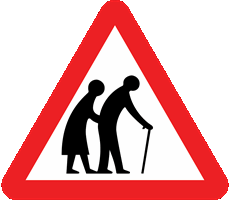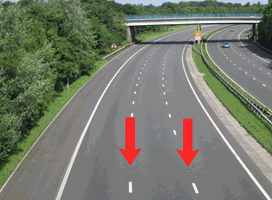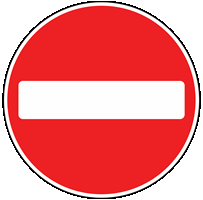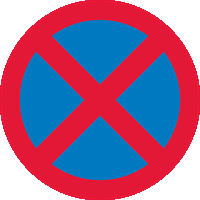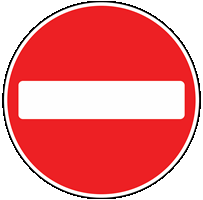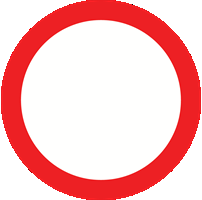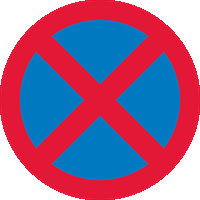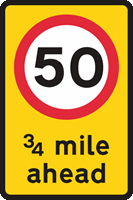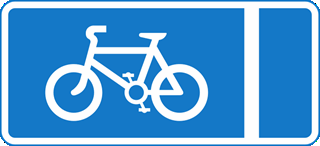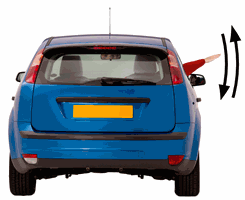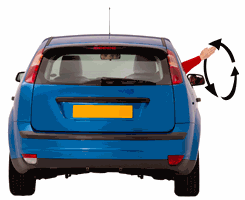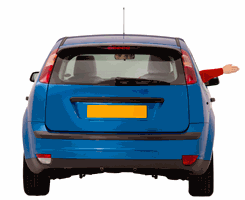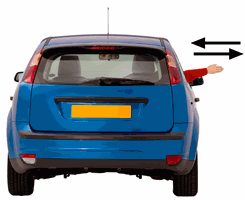You have 57 minutes to answer 50 multiple choice driving theory test questions. You need to answer at least 43 out of 50 questions correctly to pass. You can review your answer after each question or you can review all of your answers at the end of the test. Best of luck!
Test Quick View
Click on an answer to view the correct choice along with the explanation.
Correct Answer: B
Explanation: Always give cyclists plenty of room when overtaking them. You need to give them even more room when it's windy. A sudden gust could easily blow them off course and into your path.
Explanation: Always give cyclists plenty of room when overtaking them. You need to give them even more room when it's windy. A sudden gust could easily blow them off course and into your path.
Correct Answer: C
Explanation: Look well ahead to see whether any hazards are developing. This will give you more time to deal with them in the correct way. The man in the picture is clearly intending to cross the road. You should be travelling at a speed that allows you to check your mirror, slow down and stop in good time. You shouldn't have to brake harshly.
Explanation: Look well ahead to see whether any hazards are developing. This will give you more time to deal with them in the correct way. The man in the picture is clearly intending to cross the road. You should be travelling at a speed that allows you to check your mirror, slow down and stop in good time. You shouldn't have to brake harshly.
Correct Answer: A
Explanation: Be aware that older people might take a long time to cross the road. They might also be hard of hearing and not hear you approaching. Don't hurry older people across the road by getting too close to them or revving your engine.
Explanation: Be aware that older people might take a long time to cross the road. They might also be hard of hearing and not hear you approaching. Don't hurry older people across the road by getting too close to them or revving your engine.
4. Why will a motorcyclist look round over their right shoulder just before turning right?
Mark one answer
B
C
D
Correct Answer: C
Explanation: When you see a motorcyclist take a glance over their shoulder, they're probably about to change direction. Recognising a clue like this helps you to anticipate their next action. This can improve road safety for you and others.
Explanation: When you see a motorcyclist take a glance over their shoulder, they're probably about to change direction. Recognising a clue like this helps you to anticipate their next action. This can improve road safety for you and others.
5. You're following a long vehicle approaching a crossroads. The driver signals right but moves close to the left-hand kerb. What should you do?
Mark one answer
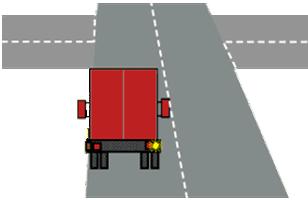
B
C
D
Correct Answer: C
Explanation: When a long vehicle is going to turn right, it may need to keep close to the left-hand kerb. This is to prevent the rear end of the trailer cutting the corner. You need to be aware of how long vehicles behave in such situations. Don't overtake the lorry, because it could turn as you're alongside. Stay behind and wait for it to turn.
Explanation: When a long vehicle is going to turn right, it may need to keep close to the left-hand kerb. This is to prevent the rear end of the trailer cutting the corner. You need to be aware of how long vehicles behave in such situations. Don't overtake the lorry, because it could turn as you're alongside. Stay behind and wait for it to turn.
B
C
D
Correct Answer: D
Explanation: There might be pedestrians crossing from in front of the bus. Look out for them if you intend to pass. Consider how many people are waiting to get on the bus - check the queue if you can. The bus might move off straight away if no-one is waiting to get on. If a bus is signalling to pull out, give it priority if it's safe to do so.
Explanation: There might be pedestrians crossing from in front of the bus. Look out for them if you intend to pass. Consider how many people are waiting to get on the bus - check the queue if you can. The bus might move off straight away if no-one is waiting to get on. If a bus is signalling to pull out, give it priority if it's safe to do so.
Correct Answer: D
Explanation: You may pass slower vehicles on their left while travelling along a one-way street. Be aware of drivers who may need to change lanes and may not expect faster traffic passing on their left.
Explanation: You may pass slower vehicles on their left while travelling along a one-way street. Be aware of drivers who may need to change lanes and may not expect faster traffic passing on their left.
8. You're travelling along a motorway. Where would you find a crawler or climbing lane?
Mark one answer
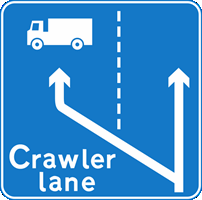
B
C
D
Correct Answer: D
Explanation: Large, slow-moving vehicles can hinder the progress of other traffic. On a steep gradient, an extra crawler lane may be provided for slow-moving vehicles to allow faster-moving traffic to flow more easily.
Explanation: Large, slow-moving vehicles can hinder the progress of other traffic. On a steep gradient, an extra crawler lane may be provided for slow-moving vehicles to allow faster-moving traffic to flow more easily.
Correct Answer: D
Explanation: White studs are found between the lanes on motorways. They reflect back the light from your headlights. This is especially useful in bad weather, when visibility is restricted.
Explanation: White studs are found between the lanes on motorways. They reflect back the light from your headlights. This is especially useful in bad weather, when visibility is restricted.
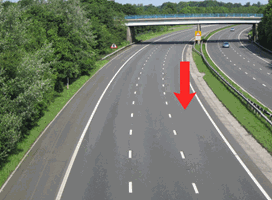
B
C
D
Correct Answer: C
Explanation: You should normally use the left-hand lane on any dual carriageway unless you're overtaking or turning right. When overtaking on a dual carriageway, look for vehicles ahead that are turning right. They may be slowing or stopped. You need to see them in good time so that you can take appropriate action.
Explanation: You should normally use the left-hand lane on any dual carriageway unless you're overtaking or turning right. When overtaking on a dual carriageway, look for vehicles ahead that are turning right. They may be slowing or stopped. You need to see them in good time so that you can take appropriate action.
Correct Answer: A
Explanation: No entry' signs are used in places such as one-way streets to prevent vehicles driving against the traffic. To ignore one would be dangerous, both for yourself and for other road users, as well as being against the law.
Explanation: No entry' signs are used in places such as one-way streets to prevent vehicles driving against the traffic. To ignore one would be dangerous, both for yourself and for other road users, as well as being against the law.
Correct Answer: C
Explanation: Clearways are stretches of road where you aren't allowed to stop unless it's an emergency. Stopping where these restrictions apply may be dangerous and is likely to cause an obstruction. Restrictions might apply for several miles and this may be indicated on the sign.
Explanation: Clearways are stretches of road where you aren't allowed to stop unless it's an emergency. Stopping where these restrictions apply may be dangerous and is likely to cause an obstruction. Restrictions might apply for several miles and this may be indicated on the sign.
Correct Answer: D
Explanation: A warning sign with a picture of a windsock indicates that there may be strong side winds. This sign is often found on exposed roads.
Explanation: A warning sign with a picture of a windsock indicates that there may be strong side winds. This sign is often found on exposed roads.
14. You're approaching a junction where the traffic lights aren't working. What should you do when a police officer gives this signal?
Mark one answer

B
C
D
Correct Answer: B
Explanation: When a police officer or traffic warden is directing traffic, you must obey them. They'll use the arm signals shown in The Highway Code. Learn what these signals mean and obey them.
Explanation: When a police officer or traffic warden is directing traffic, you must obey them. They'll use the arm signals shown in The Highway Code. Learn what these signals mean and obey them.
Correct Answer: A
Explanation: Knowing the colours of the reflective studs on the road will help you judge your position, especially at night, in foggy conditions or when visibility is poor.
Explanation: Knowing the colours of the reflective studs on the road will help you judge your position, especially at night, in foggy conditions or when visibility is poor.
Correct Answer: D
Explanation: You should know the speed limit for the road on which you're travelling and the vehicle that you're driving. The different speed limits are shown in The Highway Code.
Explanation: You should know the speed limit for the road on which you're travelling and the vehicle that you're driving. The different speed limits are shown in The Highway Code.
Correct Answer: C
Explanation: Some garages will remind you that your vehicle is due for its annual MOT test, but not all do. To ensure continuous cover, you may take your vehicle for its MOT up to one month before its existing MOT certificate runs out. The expiry date on the new certificate will be 12 months after the expiry date on the old certificate.
Explanation: Some garages will remind you that your vehicle is due for its annual MOT test, but not all do. To ensure continuous cover, you may take your vehicle for its MOT up to one month before its existing MOT certificate runs out. The expiry date on the new certificate will be 12 months after the expiry date on the old certificate.
Correct Answer: A
Explanation: In the interests of road safety, temporary mandatory speed limits are imposed at all major roadworks. Signs like this, giving advance warning of the speed limit, are normally placed about three-quarters of a mile ahead of where the speed limit comes into force.
Explanation: In the interests of road safety, temporary mandatory speed limits are imposed at all major roadworks. Signs like this, giving advance warning of the speed limit, are normally placed about three-quarters of a mile ahead of where the speed limit comes into force.
19. You're on a motorway. A lorry has stopped in the right-hand lane. What should you do when you see this sign on the lorry?
Mark one answer
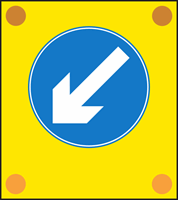
B
C
D
Correct Answer: C
Explanation: Sometimes work is carried out on the motorway without closing the lanes. When this happens, signs are mounted on the back of lorries to warn other road users of the roadworks ahead.
Explanation: Sometimes work is carried out on the motorway without closing the lanes. When this happens, signs are mounted on the back of lorries to warn other road users of the roadworks ahead.
20. The red lights are flashing. What should you do when approaching this level crossing?
Mark one answer
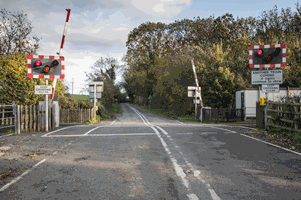
B
C
D
Correct Answer: C
Explanation: At level crossings, the red lights flash before and while the barrier is down. At most crossings, an amber light will precede the red lights. You must stop behind the white line unless you've already crossed it when the amber light comes on. Never zigzag around half-barriers.
Explanation: At level crossings, the red lights flash before and while the barrier is down. At most crossings, an amber light will precede the red lights. You must stop behind the white line unless you've already crossed it when the amber light comes on. Never zigzag around half-barriers.
Correct Answer: A
Explanation: You should only flash your headlights to warn others of your presence. Don't use them to greet others, show impatience or give priority to other road users, because they could misunderstand your signal.
Explanation: You should only flash your headlights to warn others of your presence. Don't use them to greet others, show impatience or give priority to other road users, because they could misunderstand your signal.
Correct Answer: D
Explanation: Usually, a picture of a cycle will also be painted on the road, and sometimes the lane will have a different coloured surface. Leave these areas clear for cyclists and don't pass too closely when you overtake.
Explanation: Usually, a picture of a cycle will also be painted on the road, and sometimes the lane will have a different coloured surface. Leave these areas clear for cyclists and don't pass too closely when you overtake.
23. You're travelling in the left-hand lane of a three-lane motorway. How should you react to traffic joining from a slip road?
Mark one answer
B
C
D
Correct Answer: B
Explanation: Plan well ahead when approaching a slip road. If you see traffic joining the motorway, move to another lane if it's safe to do so. This can help the flow of traffic joining the motorway, especially at peak times.
Explanation: Plan well ahead when approaching a slip road. If you see traffic joining the motorway, move to another lane if it's safe to do so. This can help the flow of traffic joining the motorway, especially at peak times.
Correct Answer: D
Explanation: Driving without insurance is a serious offence. As well as an unlimited fine, you may be disqualified or incur penalty points.
Explanation: Driving without insurance is a serious offence. As well as an unlimited fine, you may be disqualified or incur penalty points.
Correct Answer: D
Explanation: Congestion can be reduced by keeping traffic at a constant speed. At busy times, maximum speed limits are displayed on overhead gantries. These can be varied quickly, depending on the amount of traffic. By keeping to a constant speed on busy sections of motorway, overall journey times are normally improved.
Explanation: Congestion can be reduced by keeping traffic at a constant speed. At busy times, maximum speed limits are displayed on overhead gantries. These can be varied quickly, depending on the amount of traffic. By keeping to a constant speed on busy sections of motorway, overall journey times are normally improved.
26. You're approaching this roundabout and see the cyclist signal right. Why is the cyclist keeping to the left?
Mark one answer
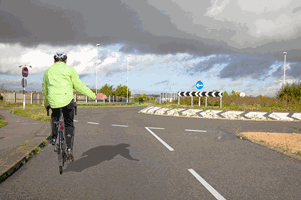
B
C
D
Correct Answer: C
Explanation: Cycling in today's heavy traffic can be hazardous. Some cyclists may not feel happy about crossing the path of traffic to take up a position in an outside lane. Be aware of this and understand that, although they're in the left-hand lane, the cyclist might be turning right.
Explanation: Cycling in today's heavy traffic can be hazardous. Some cyclists may not feel happy about crossing the path of traffic to take up a position in an outside lane. Be aware of this and understand that, although they're in the left-hand lane, the cyclist might be turning right.
Correct Answer: D
Explanation: Buses and cycles can travel in this lane. In this example, they'll flow in the same direction as other traffic. If it's busy, they may be passing you on the left, so watch out for them. Times on the sign will show the lane's hours of operation; if no times are shown, or there's no sign at all, this means the lane is in operation 24 hours a day. In some areas, other vehicles, such as taxis and motorcycles, are allowed to use bus lanes. The sign will show if this is the case.
Explanation: Buses and cycles can travel in this lane. In this example, they'll flow in the same direction as other traffic. If it's busy, they may be passing you on the left, so watch out for them. Times on the sign will show the lane's hours of operation; if no times are shown, or there's no sign at all, this means the lane is in operation 24 hours a day. In some areas, other vehicles, such as taxis and motorcycles, are allowed to use bus lanes. The sign will show if this is the case.
28. When you're overtaking a cyclist, you should leave as much room as you would give to a car. What's the main reason for this?
Mark one answer
B
C
D
Correct Answer: D
Explanation: Before overtaking, assess the situation. Look well ahead to see whether the cyclist will need to change direction. Be especially aware of a cyclist approaching parked vehicles, as they'll need to alter course. Don't pass too closely or cut in sharply.
Explanation: Before overtaking, assess the situation. Look well ahead to see whether the cyclist will need to change direction. Be especially aware of a cyclist approaching parked vehicles, as they'll need to alter course. Don't pass too closely or cut in sharply.
Correct Answer: D
Explanation: Alcohol will severely reduce your ability to drive or ride safely and there are serious consequences if you're caught over the drink-drive limit. It's known that alcohol can
- affect your judgement
- cause overconfidence
- reduced coordination and control
Explanation: Alcohol will severely reduce your ability to drive or ride safely and there are serious consequences if you're caught over the drink-drive limit. It's known that alcohol can
- affect your judgement
- cause overconfidence
- reduced coordination and control
30. After a collision, someone is unconscious in their vehicle. When should you call the emergency services?
Mark one answer
B
C
D
Correct Answer: C
Explanation: It's important to make sure that the emergency services arrive as soon as possible. When a person is unconscious, they could have serious injuries that aren't immediately obvious.
Explanation: It's important to make sure that the emergency services arrive as soon as possible. When a person is unconscious, they could have serious injuries that aren't immediately obvious.
B
C
D
Correct Answer: C
Explanation: Unblocking the casualty's airway and gently tilting their head back will help them to breathe. They'll then be in the correct position if mouth-to-mouth resuscitation is required. Don't move a casualty unless there's further danger.
Explanation: Unblocking the casualty's airway and gently tilting their head back will help them to breathe. They'll then be in the correct position if mouth-to-mouth resuscitation is required. Don't move a casualty unless there's further danger.
32. You're driving on a clear night. There's a steady stream of oncoming traffic. The national speed limit applies. Which lights should you use?
Mark one answer
B
C
D
Correct Answer: A
Explanation: Use the full-beam headlights only when you can be sure that you won't dazzle other road users.
Explanation: Use the full-beam headlights only when you can be sure that you won't dazzle other road users.
Correct Answer: D
Explanation: Uneven wear on your tyres can be caused by the condition of your vehicle. Having the vehicle serviced regularly will ensure that the brakes, steering, suspension and wheel alignment are maintained in good order.
Explanation: Uneven wear on your tyres can be caused by the condition of your vehicle. Having the vehicle serviced regularly will ensure that the brakes, steering, suspension and wheel alignment are maintained in good order.
34. You're driving on a road with several lanes. You see these signs above the lanes. What do they mean?
Mark one answer

B
C
D
Correct Answer: A
Explanation: If you see a red cross above your lane, it means that there's an obstruction ahead. You'll have to move into one of the lanes that's showing a green light. If all the lanes are showing a red cross, then you must stop.
Explanation: If you see a red cross above your lane, it means that there's an obstruction ahead. You'll have to move into one of the lanes that's showing a green light. If all the lanes are showing a red cross, then you must stop.
35. You're invited to a pub lunch. You know that you'll have to drive in the evening. What's your best course of action?
Mark one answer
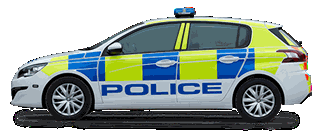
B
C
D
Correct Answer: B
Explanation: Alcohol will stay in your body for several hours and may make you unfit to drive later in the day. Drinking during the day will also affect your performance at work or study.
Explanation: Alcohol will stay in your body for several hours and may make you unfit to drive later in the day. Drinking during the day will also affect your performance at work or study.
36. You're driving on the motorway in windy conditions. What should you do as you pass a high-sided vehicle?
Mark one answer
B
C
D
Correct Answer: A
Explanation: The draught caused by other vehicles - particularly those with high sides - could be strong enough to push you out of your lane. Be prepared for a sudden gust of wind as you pass large vehicles. Keep both hands on the steering wheel to help you keep full control.
Explanation: The draught caused by other vehicles - particularly those with high sides - could be strong enough to push you out of your lane. Be prepared for a sudden gust of wind as you pass large vehicles. Keep both hands on the steering wheel to help you keep full control.
37. What should you do when you're unsure whether it's safe to reverse your vehicle?
Mark one answer
B
C
D
Correct Answer: A
Explanation: A small child could be hidden directly behind you, so, if you can't see all around your vehicle, get out and have a look. You could also ask someone reliable outside the vehicle to guide you.
Explanation: A small child could be hidden directly behind you, so, if you can't see all around your vehicle, get out and have a look. You could also ask someone reliable outside the vehicle to guide you.
38. You're approaching a zebra crossing where pedestrians are waiting. Which arm signal might you give?
Mark one answer
B
C
D
Correct Answer: A
Explanation: A 'slowing down' signal will indicate your intentions to oncoming and following vehicles. Be aware that pedestrians might start to cross as soon as they see this signal.
Explanation: A 'slowing down' signal will indicate your intentions to oncoming and following vehicles. Be aware that pedestrians might start to cross as soon as they see this signal.
39. You break down on a level crossing. The lights haven't yet begun to flash. What's the first thing you should do?
Mark one answer
B
C
D
Correct Answer: A
Explanation: If your vehicle breaks down on a level crossing, your first priority is to get everyone out of the vehicle and clear of the crossing. Then use the railway telephone, if there is one, to tell the signal operator. If you have time before the train arrives, move the vehicle clear of the crossing, but only do this if alarm signals are not on.
Explanation: If your vehicle breaks down on a level crossing, your first priority is to get everyone out of the vehicle and clear of the crossing. Then use the railway telephone, if there is one, to tell the signal operator. If you have time before the train arrives, move the vehicle clear of the crossing, but only do this if alarm signals are not on.
40. On which occasion should you inflate your tyres to more than their normal pressure?
Mark one answer
B
C
D
Correct Answer: A
Explanation: Check the vehicle handbook. This should give you guidance on the correct tyre pressures for your vehicle and when you may need to adjust them. If you're carrying a heavy load, you may need to adjust the headlights as well. Most cars have a switch on the dashboard to do this.
Explanation: Check the vehicle handbook. This should give you guidance on the correct tyre pressures for your vehicle and when you may need to adjust them. If you're carrying a heavy load, you may need to adjust the headlights as well. Most cars have a switch on the dashboard to do this.
Correct Answer: C
Explanation: The licensing authorities hold the records of all vehicles, drivers and riders in Great Britain and Northern Ireland. They need to know if you have a medical condition that might affect your ability to drive safely. You must tell them if your health deteriorates and you become unfit to drive.
Explanation: The licensing authorities hold the records of all vehicles, drivers and riders in Great Britain and Northern Ireland. They need to know if you have a medical condition that might affect your ability to drive safely. You must tell them if your health deteriorates and you become unfit to drive.
Correct Answer: C
Explanation: Any load will have an effect on the handling of your vehicle, and this becomes worse as you increase the load. You need to be aware of this when carrying passengers or heavy loads, fitting a roof rack or towing a trailer.
Explanation: Any load will have an effect on the handling of your vehicle, and this becomes worse as you increase the load. You need to be aware of this when carrying passengers or heavy loads, fitting a roof rack or towing a trailer.
Correct Answer: C
Explanation: Both recreational drugs and prescribed medicine can affect your concentration. It's also now an offence to drive with certain drugs in your body and a positive test could lead to a conviction.
Explanation: Both recreational drugs and prescribed medicine can affect your concentration. It's also now an offence to drive with certain drugs in your body and a positive test could lead to a conviction.
Correct Answer: B
Explanation: The fuel in your vehicle can be a dangerous fire hazard. If you smell fuel, check out where it's coming from. Never
- use a naked flame near the vehicle if you can smell fuel
- smoke when refuelling your vehicle
Explanation: The fuel in your vehicle can be a dangerous fire hazard. If you smell fuel, check out where it's coming from. Never
- use a naked flame near the vehicle if you can smell fuel
- smoke when refuelling your vehicle
45. You're driving past parked cars. You notice a bicycle wheel sticking out between them. What should you do?
Mark one answer
B
C
D
Correct Answer: C
Explanation: Scan the road as you drive. Try to anticipate hazards by being aware of the places where they're likely to occur. You'll then be able to react in good time.
Explanation: Scan the road as you drive. Try to anticipate hazards by being aware of the places where they're likely to occur. You'll then be able to react in good time.
46. You're driving on a wet motorway with surface spray. What lights should you use?
Mark one answer
B
C
D
Correct Answer: A
Explanation: When surface spray reduces visibility, switch on your dipped headlights. This will help other road users to see you.
Explanation: When surface spray reduces visibility, switch on your dipped headlights. This will help other road users to see you.
47. Your car requires an MOT certificate. When is it legal to drive it without an MOT certificate?
Mark one answer
B
C
D
Correct Answer: D
Explanation: When a car is three years old (four years old in Northern Ireland), it must pass an MOT test and have a valid MOT certificate before it can be used on the road. Exceptionally, you may
- drive to a pre-arranged test appointment or to a garage for repairs required for the test
- drive vehicles made before 1960 without an MOT test, but they must be in a roadworthy condition before being used on the road
Explanation: When a car is three years old (four years old in Northern Ireland), it must pass an MOT test and have a valid MOT certificate before it can be used on the road. Exceptionally, you may
- drive to a pre-arranged test appointment or to a garage for repairs required for the test
- drive vehicles made before 1960 without an MOT test, but they must be in a roadworthy condition before being used on the road
Correct Answer: D
Explanation: Coasting is when you allow the vehicle to freewheel in neutral or with the clutch pedal depressed. Speed will increase as you lose the benefits of engine braking and have less control. You shouldn't coast, especially when approaching hazards such as junctions or bends and when travelling downhill.
Explanation: Coasting is when you allow the vehicle to freewheel in neutral or with the clutch pedal depressed. Speed will increase as you lose the benefits of engine braking and have less control. You shouldn't coast, especially when approaching hazards such as junctions or bends and when travelling downhill.
Correct Answer: B
Explanation: The emphasis is on hazard awareness and planning ahead. By looking well ahead, you'll have plenty of time to deal with hazards safely and won't need to brake sharply. This will also reduce damage to the environment.
Explanation: The emphasis is on hazard awareness and planning ahead. By looking well ahead, you'll have plenty of time to deal with hazards safely and won't need to brake sharply. This will also reduce damage to the environment.
Correct Answer: C
Explanation: Any load must be securely fastened to the vehicle. The safest way to carry items on the roof is in a specially designed roof box. This will help to keep your luggage secure and dry, and it also has less wind resistance than loads carried exposed on a roof rack.
Explanation: Any load must be securely fastened to the vehicle. The safest way to carry items on the roof is in a specially designed roof box. This will help to keep your luggage secure and dry, and it also has less wind resistance than loads carried exposed on a roof rack.




